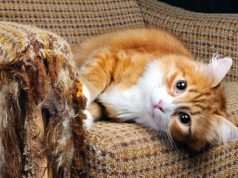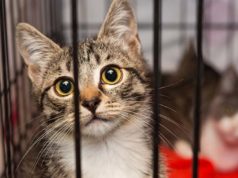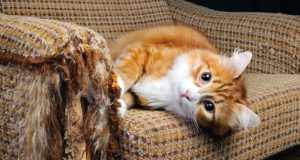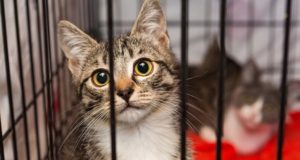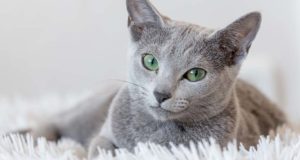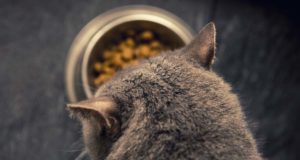Dealing with hairballs is not a pleasant thing, neither for you or your cat. She has to go through retching and vomiting, and you have to clean that mess. So what is the best hairball remedy for cats, and what will do an effective job without harming your cat?
Hairballs are normal for cats. It is, in most cases, not a reason to be alarmed since it is a natural occurrence. However, there are many things you can do to help your cat with this issue, and avoid cleaning the hairballs every other day. Let’s see what the best hairball remedy for cats is and what you can and should do about this.
ALSO READ: 25 Most Common Cat Diseases and How to Prevent Them
What Is the Best Hairball Remedy for Cats?
What are Hairballs?
Before we get into what the best hairball remedy for cats is, we must understand how these nasty balls of hair appear on your carpet and why cats are the exclusive carriers of hairballs among all pets.
Cats groom themselves by licking their fur and during this process they swallow a lot of their hair. In most situations, cats will digest the hair that they swallow and eliminate them with the feces, but sometimes the hair doesn’t go through the intestinal tract. In those cases, the hair gets stuck and your cat has to find an alternative way to eliminate the hair. That leads to vomiting and you get a nicely shaped hairball on your rug.

Dr Karen Becker warns pet owners about the serious problems hairballs in cats can cause, and the reason why every pet owner must look into how to deal with them.
Even though all cats can have problems with hairballs, cats with longer hair are particularly susceptible to getting hairballs. Even with short-haired cats like American Shorthair or Exotic Shorthair, it is important to regularly groom your cat to help her ingest less hair, but with long-haired cats this is even more important. In fact, some cat breeds will require brushing or combing on a daily basis.
What is actually the best hairball remedy for cats?
Fortunately or not, the best hairball remedy for cats – most of them, at least – is exactly what you would use for preventing hairballs in the first place. There are many natural remedies, as well as pharmaceutical medicine that can help your cat pass the hairballs when they become stuck, but the most effective way to deal with hairballs is prevention.
“If there seems to be an abnormal amount of hairballs produced, then steps should be taken to prevent the pet from ingesting large amounts of hair or to help the hair move through the GI tract before it accumulates together.” – James Barr, DVM at Texas VetMed
There are several ways to prevent hairballs in cats, and those same methods will work well as the best hairball remedy for cats as well. So, how do you prevent hairballs in your feline, and what actually works without harming your cat? Let’s take a look.
How to Prevent Hairballs in Cats
The best way to prevent hairballs in cats is to find ways how to navigate all that hair your cat swallows and to have her eliminate it through feces, and not through vomiting. This method is the basis for prevention and works as the best hairball remedy for cats.
Obviously, preventing hairballs in cats is a much better alternative to cleaning up after your feline, not to mention the fact that your pet would certainly thank you for it since it is much easier to eliminate excess hair through feces than through vomiting and retching. There are many remedies to help you deal with this problem, both pharmaceutical and homeopathic, and you should try them and see what works best.
Regular grooming
 The absolute best hairball remedy for cats is ensuring less hair on your cat, which can be accomplished through brushing and grooming sessions of your feline companion.
The absolute best hairball remedy for cats is ensuring less hair on your cat, which can be accomplished through brushing and grooming sessions of your feline companion.
Regular grooming of your cat is the best way to prevent hairballs because it will stop the source at its start, prevent hairs from getting ingested by your pet. Of course, you can’t prevent your cat from swallowing hair completely, but limiting the hair intake will certainly help. You should try to groom your cat’s fur every day, and if you have a cat with a particularly long coat, then even twice a day is not too much.
In addition to this, regular grooming will have a positive emotional impact on your cat because you will spend some quality time with her. Keeping your cat’s coat clean and nice will also help with some skin conditions and you will also be able to notice any skin anomalies better. For example, if you have a cat that spends a lot of time outdoors, you might spot some ticks on her coat if you brush your cat’s hair every day.
Fiber in Cat Food
Proper diet can be considered as another best hairball remedy for cats due to how closely these two things are related. Adding fiber to your cat’s food can help move things along and speed up the digesting process. Any excess hairballs that she has stuck in her stomach will be better digested with fiber.
There are many ways to add fiber to her diet, but perhaps the most natural one is with adding a bit of fruits and vegetables, especially if you’re into homemade cat foods and cooking for your pet. Carrots, sweet potatoes and apples have a lot of natural fiber and you can just slice them up into small pieces for your cat.
You can also give your cat some canned pumpkin, which is also a great source of fiber and many cats also love the taste of it. You can mix it into her food or just place it on a dish for her to eat. One teaspoon a day is enough to help your cat with digestion of those irritating hairballs. Other human foods for cats can also be helpful for this.
Even though most fruits and vegetables can be consumed by cats, you should still consult with your vet before you add them to her diet. For example, some cats can be harmed by grapes, raisins or seedy fruits, and there are plenty of other human foods that are always much too dangerous for cats to consume. Consult with a veterinarian and make sure that it is safe for you to add specific fruits and vegetables to your cat’s diet.
 Another good source of fiber is cat grass which grows quickly and doesn’t require a lot of care. It is also pretty cheap, which makes it a truly economic and renewable source of fiber for your cat, as well as enjoyment since many cats like to play with cat grass.
Another good source of fiber is cat grass which grows quickly and doesn’t require a lot of care. It is also pretty cheap, which makes it a truly economic and renewable source of fiber for your cat, as well as enjoyment since many cats like to play with cat grass.
There are also plenty cheap cat foods that claim to help prevent hairballs. The majority of these foods have a high volume of fiber to help the gastrointestinal tract of your cat moving normally – that’s their main selling point. However, these foods are not always effective and not every cat will react the same way to these cat foods.
Natural Oils in Cat’s Diet
On top of fiber in your cat’s diet, another best hairball remedy for cats that you should consider is natural oils. Adding them to your cat’s diet, whether it is vegetable or fish oil, will work. This will help her move those nagging hairballs along, but it will also help her have a more beautiful and shiny coat. Just mix a teaspoon of oil into her canned food and you will help her pass the hairballs by simply making them slippery in her tummy.
Another thing that can help in a similar way as oils is a homeopathic herbal medicine that is made from slippery elm, which is a type of tree bark. You should mix a little bit of slippery elm with your cat’s food every day to help her eliminate hairballs. Just be careful not to use too much, simply cover the bottom of your teaspoon and add it to her food.
Plenty of Water
You need to make sure that your cat drinks enough water every day. Fresh and clean water is the cornerstone of digestion and you need to pay special attention to your cat’s water intake and optimize it. In general, cats should drink around 4 ounces of water in addition to their food. However, if your cat doesn’t eat much of wet canned food and eats a lot of dry food, you should probably make sure that she gets even more than that.
If your cat struggles to drink enough water, you should help her out. For example, you should use stainless steel or glass bowls because plastic can leave a taste that might discourage your kitty from drinking water. Also, refresh her bowl every day and make sure that she always has fresh and clean water to drink. Using filtered water is also a good idea since tap water can contain too many minerals and chlorine.
Petroleum
 As the final solution among the best hairball remedy for cats is using any products that contain petroleum. These remedies act as a lubricant and help the hairballs get evacuated through the intestinal tract. However, these remedies are not effective in all situations and some cats don’t react well to them. In fact, you should first consult your vet before you administer these remedies because some of them can actually be harmful to your cat.
As the final solution among the best hairball remedy for cats is using any products that contain petroleum. These remedies act as a lubricant and help the hairballs get evacuated through the intestinal tract. However, these remedies are not effective in all situations and some cats don’t react well to them. In fact, you should first consult your vet before you administer these remedies because some of them can actually be harmful to your cat.
Similar to these hairball remedies are laxatives, since most laxatives are petroleum-based and they are all flavored so your cat doesn’t refuse to eat them. There are also laxatives that are petroleum-free, but in both cases, you need to be careful when you use laxatives with cats. You need to make sure that you administer the proper dose of laxatives, and it is always better to go with natural solutions than pharmaceutical.
Take Hairballs Seriously
It’s great that you’re researching the best hairball remedy for cats, because many pet owners simply assume that because it’s natural for cats to experience hairballs, it can never because a problem. This assumption is wrong.
Even though hairballs are normal for cats and most of them are harmless, your cat could also have a serious problem. If you notice that she is retching repeatedly and that she hasn’t eaten anything for more than a day, you should take her to the vet. In some cases, the hairball needs to be removed surgically, and even if that is not the case, your vet will give you advice on how to deal with your specific cat’s hairball problem long-term.
Don’t wait for problems to become serious; take your cat to the vet at the first sign of trouble. If she is dealing with hairballs much too often, she might have an underlying medical condition. For example, your cat might be suffering from impaction, which means that something is stuck in her digestive tract and she can’t vomit or eliminate waste due to that blockage. 1/4 of all impaction cases in cats is caused by hairballs.
If you notice that your kitty has diarrhea or constipation and a swollen abdomen, if she is vomiting undigested food or retching too often, you should see your vet as soon as possible. This can be a life-threatening condition if you don’t react on time and surgery might be necessary. Take hairballs seriously!



